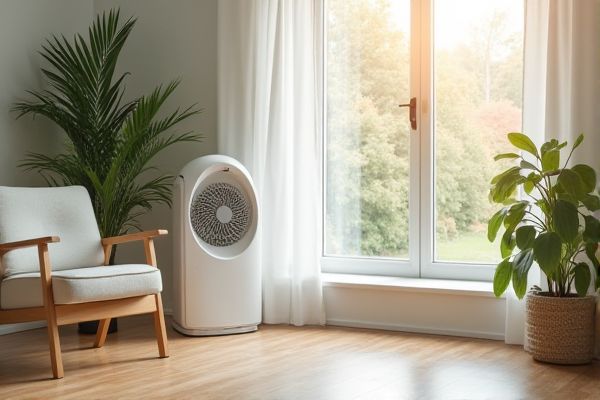
An air purifier effectively removes airborne pollutants and allergens from indoor spaces, enhancing your home's air quality, while an outdoor fan primarily circulates air to provide cooling without filtering contaminants. Discover how to choose the right device for your needs by reading the rest of this article.
Table of Comparison
| Feature | Air Purifier | Outdoor Fan |
|---|---|---|
| Primary Function | Filters indoor air to remove pollutants, allergens, and odors | Circulates outdoor air to create cooling breeze |
| Usage Area | Indoor spaces (homes, offices) | Outdoor spaces (patios, gardens) |
| Air Quality Improvement | Removes dust, pollen, smoke, mold spores, bacteria, and viruses | No direct air purification, only air movement |
| Cooling Effect | No cooling, only air purification | Provides cooling breeze by increasing air circulation |
| Filters | HEPA, activated carbon, UV light filters | No filters |
| Energy Consumption | Moderate to high depending on filter type and size | Generally lower energy use than air purifiers |
| Noise Level | Low to moderate, varies by model | Low to high, depends on fan speed and type |
| Maintenance | Regular filter replacement required | Minimal, primarily cleaning fan blades |
| Cost | Higher upfront cost with ongoing filter expenses | Generally lower cost and maintenance |
| Ideal For | Improving indoor air quality, allergy relief | Cooling outdoor areas, improving air circulation |
Introduction: Air Purifier vs Outdoor Fan
Air purifiers and outdoor fans serve distinct purposes in improving air quality and comfort. Air purifiers remove pollutants, allergens, and airborne particles to create a cleaner indoor environment, while outdoor fans primarily provide airflow to enhance ventilation and cooling. Understanding the differences helps you choose the right solution for either reducing indoor air contaminants or increasing outdoor air circulation.
How Air Purifiers Work
Air purifiers function by drawing indoor air through filters that capture dust, allergens, smoke, and airborne pollutants, improving overall air quality. Unlike outdoor fans that circulate outdoor air without filtering, air purifiers actively remove harmful particles to reduce respiratory irritants. Your indoor environment benefits from cleaner, healthier air through advanced filtration technologies such as HEPA and activated carbon filters.
How Outdoor Fans Operate
Outdoor fans work by circulating air to create a cooling breeze, effectively reducing the perceived temperature in open spaces by accelerating the evaporation of sweat from your skin. Unlike air purifiers that filter out airborne pollutants, outdoor fans do not remove contaminants but improve air movement and ventilation. These devices typically utilize large, high-speed blades powered by electric motors to push air over a wide area, enhancing comfort during warm weather.
Key Differences Between Air Purifiers and Outdoor Fans
Air purifiers use advanced filtration systems like HEPA filters and activated carbon to remove pollutants, allergens, and airborne particles, enhancing indoor air quality. Outdoor fans primarily circulate air to provide cooling and improve ventilation but do not filter or remove contaminants. The key difference lies in air purifiers' ability to clean air versus outdoor fans' role in airflow and temperature regulation.
Effectiveness in Improving Air Quality
Air purifiers are highly effective in improving indoor air quality by filtering out pollutants such as dust, allergens, smoke, and harmful microorganisms. Outdoor fans primarily enhance ventilation by moving air but do not remove airborne contaminants or improve overall air purity. Choosing an air purifier for your space ensures targeted removal of pollutants, delivering cleaner and healthier air compared to the general airflow provided by outdoor fans.
Energy Consumption Comparison
Air purifiers typically consume between 50 to 100 watts depending on the model and settings, making them energy-efficient for indoor air quality improvement. Outdoor fans, especially large or industrial types, can use significantly more power, ranging from 100 to 300 watts, due to their need to move larger volumes of air. Your choice should consider that while air purifiers optimize indoor air by filtering pollutants, outdoor fans primarily provide ventilation with higher energy use.
Noise Levels: What to Expect
Air purifiers typically operate at low noise levels ranging from 20 to 50 decibels, making them suitable for quiet environments like bedrooms or offices. Outdoor fans generally produce higher noise, averaging around 50 to 70 decibels, due to larger blades and higher airflow capacity. Understanding these differences helps you select the appropriate appliance based on your noise tolerance and environment.
Maintenance and Longevity
Air purifiers require regular filter replacement and cleaning to maintain optimal performance and ensure air quality, typically every 3 to 6 months depending on usage. Outdoor fans need periodic dusting and lubrication of moving parts to prevent wear and extend motor life, but generally offer a longer lifespan with less frequent maintenance. Choosing the right device depends on your specific needs for air purification or ventilation, balancing upkeep efforts with the expected durability.
Cost and Affordability
Air purifiers generally have a higher upfront cost compared to outdoor fans, often ranging from $100 to $600 or more based on features and brand. Operating expenses for air purifiers include filter replacements and electricity usage, which can add to your ongoing costs. Outdoor fans are usually more affordable with lower initial prices and minimal maintenance, but they don't offer air-cleaning benefits like purifiers do.
Which One Should You Choose?
Choosing between an air purifier and an outdoor fan depends on your specific needs: air purifiers are ideal for improving indoor air quality by removing allergens, pollutants, and dust, while outdoor fans are designed to enhance ventilation and provide cooling in open-air environments. For allergy sufferers or those living in urban areas with high pollution, air purifiers with HEPA filters offer significant health benefits by capturing microscopic particles. Conversely, outdoor fans are more suitable for user comfort in warm climates, promoting airflow but lacking filtration capabilities.
 homyna.com
homyna.com